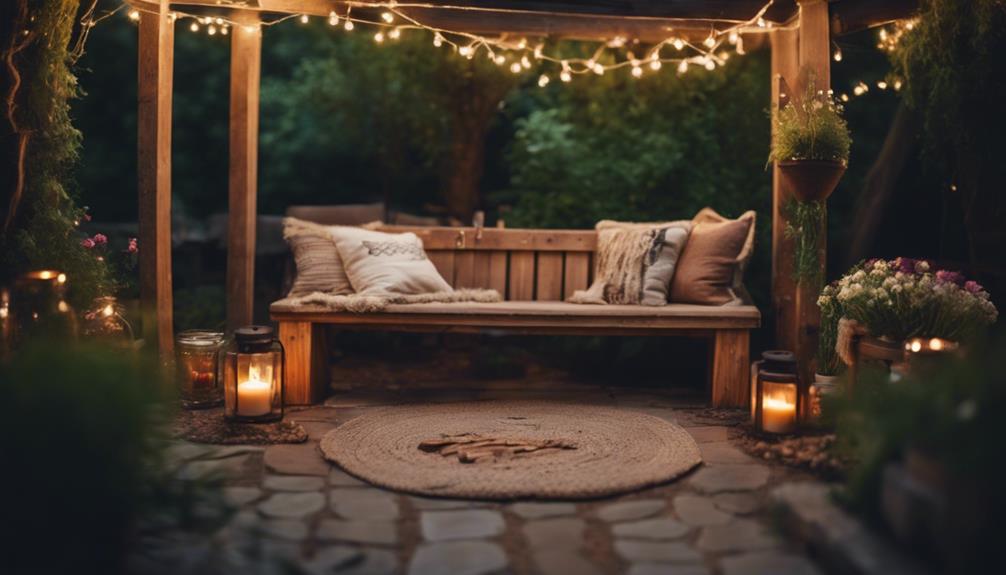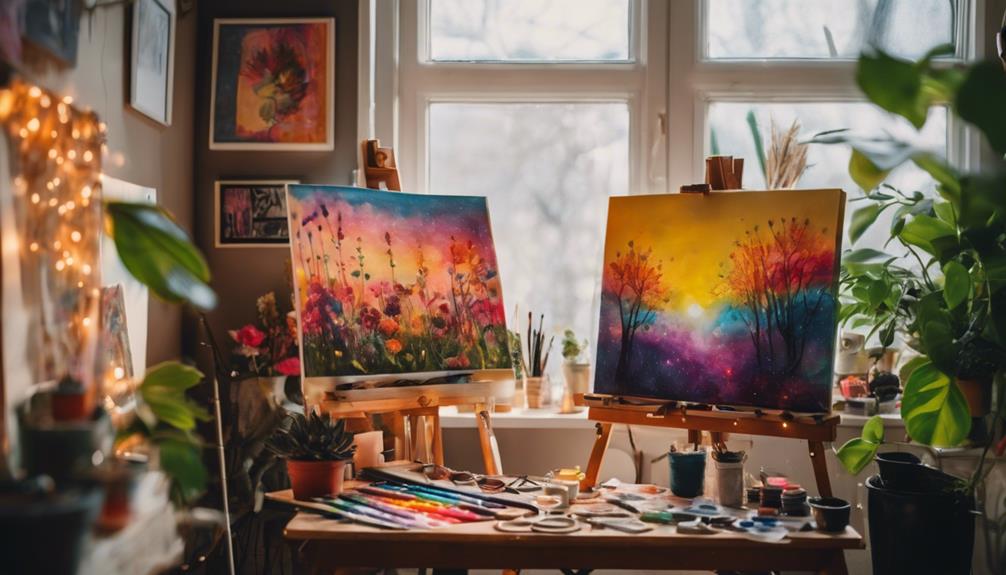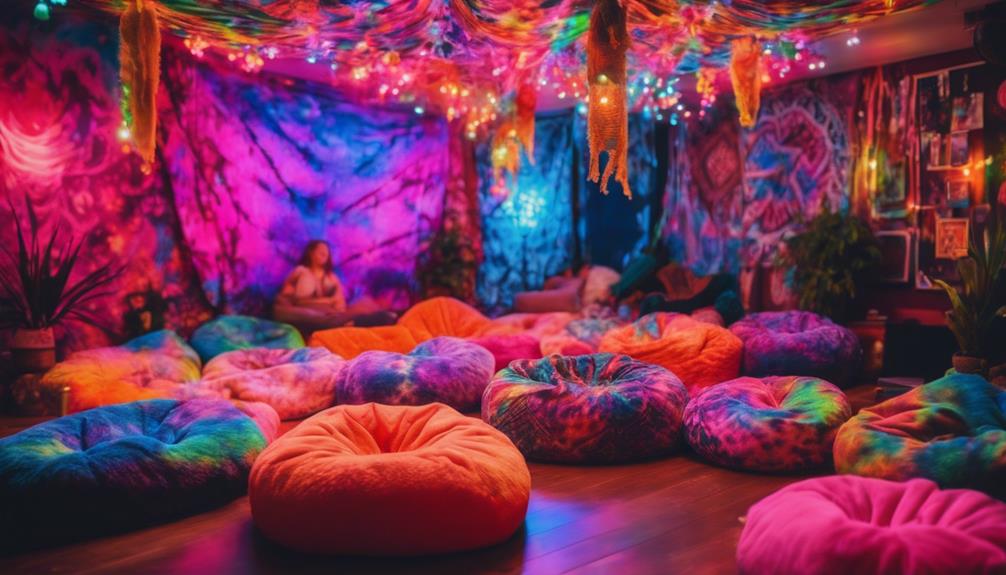You can easily create a charming country-inspired outdoor space in a small yard. Start with a serene color palette of earthy tones like sage green and warm browns. Incorporate functional fixtures such as a compact wrought iron bistro table and vintage wooden benches adorned with soft cushions. Add vertical gardening solutions like hanging flower pot racks and use string lights to create a cozy atmosphere. For flooring, consider reclaimed wood decking or flagstone pavers. Enhance the rustic charm with decorative elements like handcrafted pots or lanterns. Keep going to discover more ideas that will bring your vision to life.
Key Elements
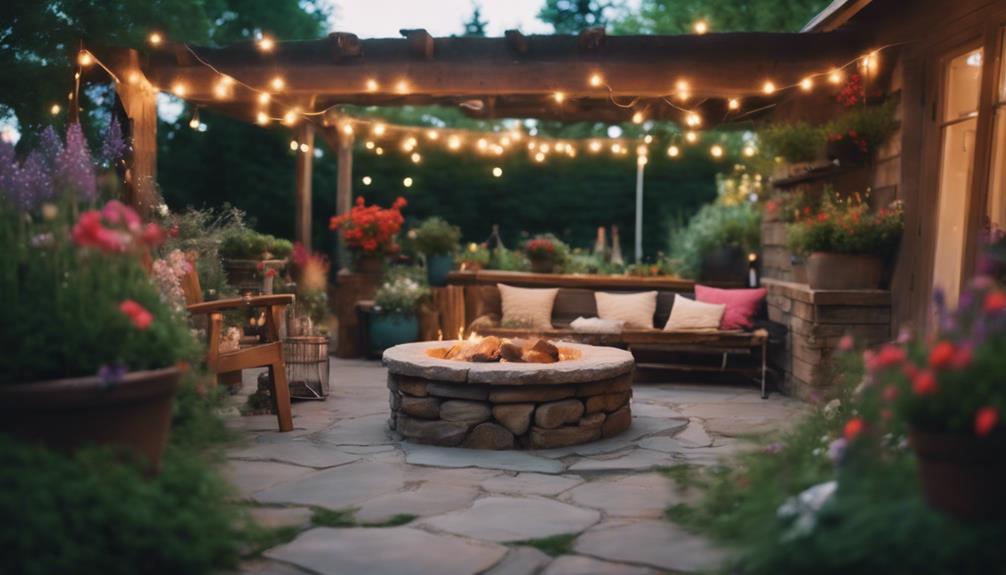
When designing your outdoor space, the color scheme, materials, and textures you choose play an essential role in setting the mood.
You can create harmony and visual interest by selecting complementary colors and varied surfaces.
Let's explore how each element can enhance your outdoor experience.
Color Scheme
Embracing a serene color palette with earthy tones like sage green and warm browns can transform your outdoor space into a cohesive and inviting retreat. To achieve this country-inspired look, consider rustic wooden furniture finished in natural tones or painted in soft pastel shades. These elements invite comfort while staying stylish.
You can also add a little bit of vibrancy with flower pots or cushions in hues like lavender or deep red. This subtle pop of color will keep your space visually interesting without overwhelming the peaceful atmosphere. Incorporate galvanized metal accents, such as planters or decorative items, to introduce a vintage charm that complements the overall theme and adds texture to your color scheme.
Don't forget about lighting! Soft string lights in warm white or rustic lanterns can create a cozy ambiance, making your outdoor area perfect for evening gatherings around the fire pit.
Materials
To create a harmonious outdoor space, selecting the right materials is just as important as choosing the perfect color scheme. Start by incorporating reclaimed wood for your furniture and decor elements. Not only does it enhance the rustic charm typical of country-inspired designs, but it's also eco-friendly and cost-effective.
Next, consider galvanized metal planters and pots. These durable pieces evoke a farmhouse aesthetic and are perfect for showcasing seasonal flowers or herbs, adding a vibrant touch to your space. For pathways and seating areas, opt for fine crushed stones or gravel. They provide an easy-to-maintain surface that complements the natural landscape beautifully.
When it comes to textiles, choose outdoor cushions in soft, muted color palettes. These hues reflect the serene vibes of country living, helping to create a cohesive and inviting atmosphere.
Finally, don't forget about lighting. Incorporating natural lighting solutions like string lights or battery-operated lanterns adds warmth and charm in the evenings, enhancing the cozy ambiance of your outdoor area.
With these materials, you'll craft an inviting outdoor space that embodies the essence of country living, even in a small yard.
Textures
Incorporating a variety of textures transforms your outdoor space into a warm and inviting retreat. Start with reclaimed wood for your furniture, which brings a rustic charm. Add soft outdoor cushions to enhance comfort and style. Rugged stone pathways can ground your design, creating a contrast that's visually appealing in a limited area.
Textiles play a significant role, too. Use burlap or linen for table runners and throw pillows, blending comfort with rustic elegance. To introduce natural elements, consider potted plants in galvanized or terracotta pots, mixing smooth and rough surfaces that evoke a country feel.
Layered outdoor rugs can also add depth. A jute base topped with a patterned outdoor mat defines different zones while enhancing texture.
Essential Fixtures and Furniture
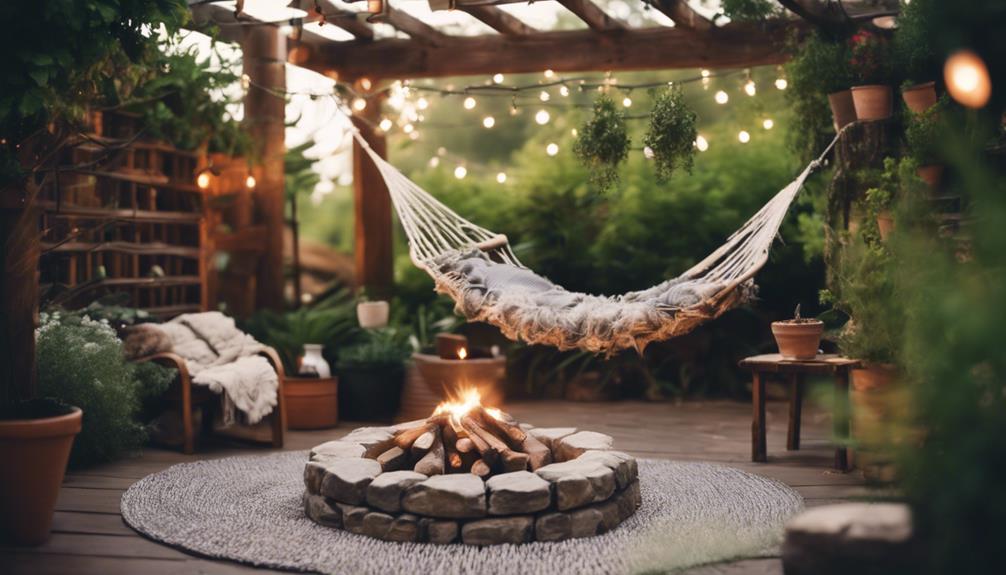
When you're setting up your outdoor space, choosing the right fixtures and furniture can make all the difference.
A wrought iron bistro table offers both style and functionality, while a vintage wooden garden bench adds character and comfort.
Don't forget a hanging flower pot rack to showcase your plants and elevate the overall design.
Wrought Iron Bistro Table
A wrought iron bistro table transforms small outdoor spaces into charming venues for intimate dining or cozy coffee moments. This elegant choice perfectly complements a country-inspired aesthetic while providing durability for year-round outdoor use. With intricate designs and a compact size—typically around 30 inches in diameter—these tables are ideal for creating inviting spots without overwhelming your space.
Pair your bistro table with matching wrought iron chairs to enhance both the visual appeal and comfort for outdoor gatherings. Not only do these pieces work well together, but they also invite you and your guests to enjoy leisurely meals or casual conversations under the open sky.
To elevate the charming vibe further, consider adding potted plants or decorative lanterns atop the table. This addition not only adds a touch of greenery but also enhances the functionality of your outdoor area.
Whether you're sipping morning coffee or sharing a light meal, a wrought iron bistro table serves as the perfect centerpiece for your cozy oasis. With its timeless style and practical design, you'll create an outdoor space that feels inviting and distinctly country-inspired.
Vintage Wooden Garden Bench
A vintage wooden garden bench offers a perfect blend of functionality and rustic charm, making it an essential fixture for any country-inspired outdoor space. This bench serves not only as a cozy seating area but also as a decorative focal point that enhances the overall aesthetic.
When selecting your bench, opt for materials like weather-resistant wood, such as teak or cedar, to guarantee it withstands the elements and lasts for years.
To elevate comfort and style, add soft outdoor cushions in earthy tones or floral patterns. This little touch makes the bench an inviting spot for relaxation, whether you're reading a book or simply enjoying nature.
Position your vintage bench strategically within your outdoor space, perhaps nestled among flowering plants or shaded by a tree, to create a picturesque nook.
Consider pairing the bench with other rustic elements like a small side table or repurposed crates, which not only complement the country theme but also maximize functionality in a limited yard.
With these thoughtful touches, your vintage wooden garden bench will become a cherished part of your outdoor sanctuary.
Hanging Flower Pot Rack
How can a hanging flower pot rack transform your outdoor space while maximizing vertical gardening opportunities? A hanging flower pot rack allows you to make the most of limited space, letting you display a variety of plants without crowding your ground area.
Opt for a sturdy, weather-resistant material like galvanized steel or treated wood to guarantee it withstands the elements.
Choosing a tiered design can create a beautiful cascading effect, adding depth and character to your outdoor environment. To enhance visual appeal, use lightweight, brightly colored pots that bring a cheerful vibe and complement your country-inspired aesthetic.
Incorporate hooks or brackets to make it easy to rearrange your pots. This flexibility allows you to change your floral display according to the seasons or showcase different flower varieties throughout the year.
With a hanging flower pot rack, you can effortlessly add charm and greenery to your outdoor space, making it feel vibrant and inviting, regardless of its size. By utilizing vertical space, you'll create a lush atmosphere that's both functional and aesthetically pleasing.
Lighting Ideas
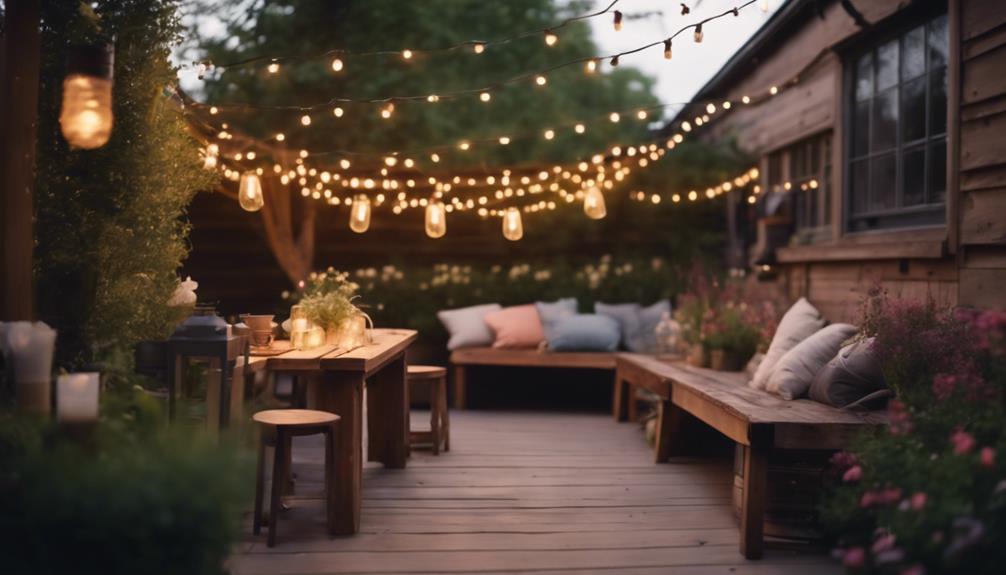
When it comes to lighting your outdoor space, you've got some fun options to contemplate.
Think about string lights with vintage bulbs for a nostalgic vibe, or lanterns on your table surfaces for a warm glow.
Don't forget solar pathway lights and candlelit mason jar centerpieces to enhance both safety and ambiance.
String Lights With Vintage Bulbs
String lights with vintage bulbs instantly transform your outdoor space into a cozy retreat, perfect for gatherings under the stars. These lights create a warm and inviting atmosphere, enhancing the country-inspired aesthetic while providing effective illumination for your evening get-togethers.
When selecting string lights, opt for weather-resistant options that feature LED vintage bulbs. They're energy-efficient and built to last, ensuring you can enjoy them season after season. To maximize their impact in your limited yard, drape them along fences, across seating areas, or around gazebos. This helps define zones and adds visual interest to your space.
For greater versatility, consider incorporating dimmable string lights. This allows you to adjust the brightness for different occasions—whether it's a cozy family dinner or a lively outdoor party. Additionally, mixing string lights with other decorative elements like lanterns or candles can create layers of light, contributing to a relaxed, country-inspired ambiance.
With vintage string lights, you can elevate your outdoor experience, making it a charming haven that invites enjoyment and connection, even in a smaller yard. Embrace this lighting option to enhance your outdoor gatherings and create lasting memories.
Lanterns on Table Surfaces
Incorporating battery-operated lanterns on table surfaces frequently enhances the ambiance of your outdoor gatherings, providing warm light without the hassle of cords. These lanterns not only offer practical illumination but also bring a charming aesthetic that complements your country-inspired theme.
To make the most of your space, choose lanterns that reflect a rustic or vintage design, utilizing materials like metal or glass. This will help tie your decor together and create a cozy atmosphere. Experiment with varying heights and sizes of lanterns on your tables to add visual interest and dimension. A layered look draws the eye and invites guests to linger.
For added safety, consider using LED candles inside your lanterns. They mimic the flickering effect of real flames while eliminating the risk of fire. Position your lanterns strategically on dining tables or side tables near seating areas, ensuring adequate lighting for meals and conversations.
This thoughtful placement not only enhances functionality but also adds decorative charm to your outdoor space. By incorporating these elements, your gatherings will feel inviting and warm, perfect for creating lasting memories under the stars.
Solar Pathway Lights
Adding solar pathway lights can beautifully enhance your outdoor space, providing eco-friendly illumination that guides guests safely while complementing the warm ambiance created by your lanterns. These lights harness sunlight during the day, guaranteeing you don't rack up electricity costs. With many models equipped with motion sensors, they brighten up when movement is detected, enhancing security—perfect for smaller yards.
Installation is a breeze, too. There's no wiring or need for professional help, allowing you to easily place them along pathways, garden beds, or patios. This flexibility not only boosts safety but also adds an inviting charm to your outdoor setting.
When choosing solar pathway lights, consider options with high lumens for brighter illumination and longer battery life. This way, you'll assure they effectively light up your space throughout the night. Available in various designs, you can find styles that perfectly align with your country-inspired theme, blending function with aesthetics.
Candlelit Mason Jar Centerpieces
Transform your outdoor gatherings into enchanting experiences with candlelit mason jar centerpieces that effortlessly blend rustic charm and warm illumination.
Start by filling your mason jars with sand or pebbles to secure tea lights or votive candles, adding a delightful touch to your space. For a whimsical flair, consider placing string lights inside larger mason jars; this creates a magical glow that enhances the ambiance as evening falls.
To elevate the romantic atmosphere, opt for scented candles in your jars. Not only will they provide soft lighting, but they'll also fill your outdoor area with inviting fragrances, making it feel cozy and welcoming.
Varying the sizes of your mason jars, from pint to quart, can add visual interest and depth to your table setting while tying in that country-inspired theme.
For a polished look and added safety, set your mason jar centerpieces on vintage wooden trays or burlap runners. This not only creates a cohesive display but also invites your guests to relax and enjoy the enchanting atmosphere you've crafted.
With these simple touches, your outdoor gatherings will feel warm, inviting, and beautifully designed.
Decorative Elements
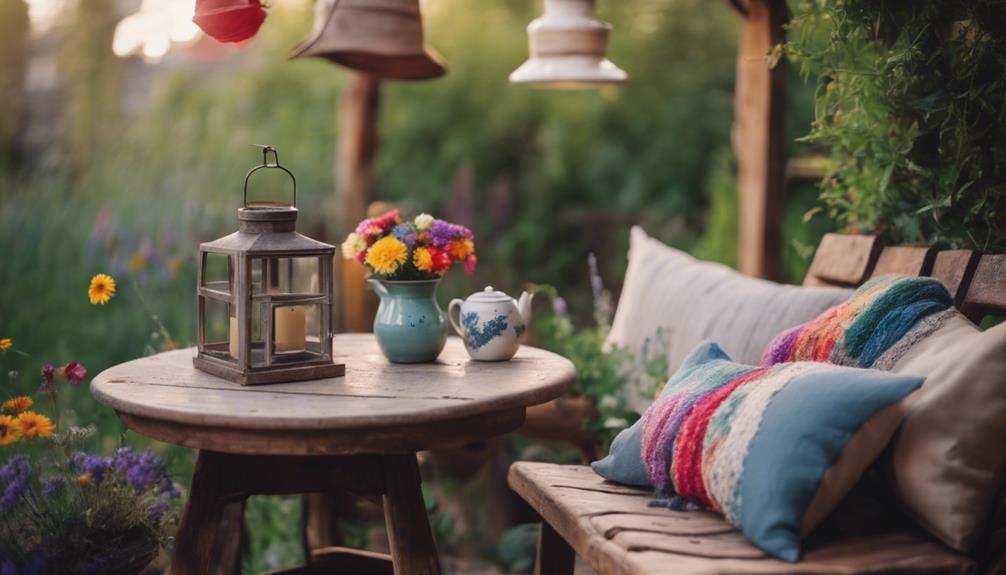
To elevate your outdoor space, consider adding rustic ceramic garden sculptures that bring character and charm.
Hand-painted terracotta plant pots can add a splash of color while showcasing your favorite plants.
An antique French wall clock not only serves as a functional piece but also enhances the vintage vibe of your area.
Rustic Ceramic Garden Sculptures
Rustic ceramic garden sculptures bring unique character and a handmade aesthetic to your outdoor space, making them ideal focal points even in smaller yards. You'll find these sculptures in a variety of designs, from charming animals to whimsical figures and abstract shapes. This variety allows you to express your personal style and complement the overall theme of your garden.
When choosing sculptures, opt for weather-resistant ceramic materials to guarantee they stand up to the elements, maintaining their beauty and integrity over time. Strategically placing a few sculptures can create visual interest, drawing the eye and defining different zones within your compact area. You can even mix and match designs to enhance the rustic charm of your outdoor space.
Moreover, by supporting local artisans who create these unique sculptures, you not only add a personal touch to your garden but also promote sustainable practices. This connection to local craftsmanship further enriches the aesthetic you're aiming for, making your outdoor space feel more inviting and full of character.
Hand-Painted Terracotta Plant Pots
Hand-painted terracotta plant pots bring a personalized flair to your outdoor space, showcasing your creative style and enhancing the country-inspired aesthetic. You can express your personality by choosing designs that resonate with you, whether through vibrant florals, rustic patterns, or charming animal motifs. These elements not only add character but also blend beautifully with the natural surroundings.
To guarantee your creations last, opt for weather-resistant acrylic paints instead of traditional ones, as they're less likely to chip or fade in outdoor conditions. After painting, don't forget to apply a sealant to protect your artwork from moisture and UV rays, helping maintain its vibrant look over time.
Varying the sizes of your pots can create visual interest, so consider grouping them in clusters on steps, tables, or shelves. This approach invites a warm, welcoming atmosphere perfect for a cozy outdoor retreat.
Antique French Wall Clock
Incorporating an antique French wall clock into your outdoor space adds a charming focal point that beautifully complements the personalized touch of hand-painted terracotta plant pots. These clocks often feature intricate designs, crafted from wood or wrought iron, bringing vintage character and sophistication to your patio or garden area.
What's great is that many antique French wall clocks are built to withstand outdoor conditions, making them practical decorative elements for covered spaces. Imagine the soft ticking sound enhancing the serene ambiance, encouraging relaxation as you sip tea or enjoy a good book.
Flooring
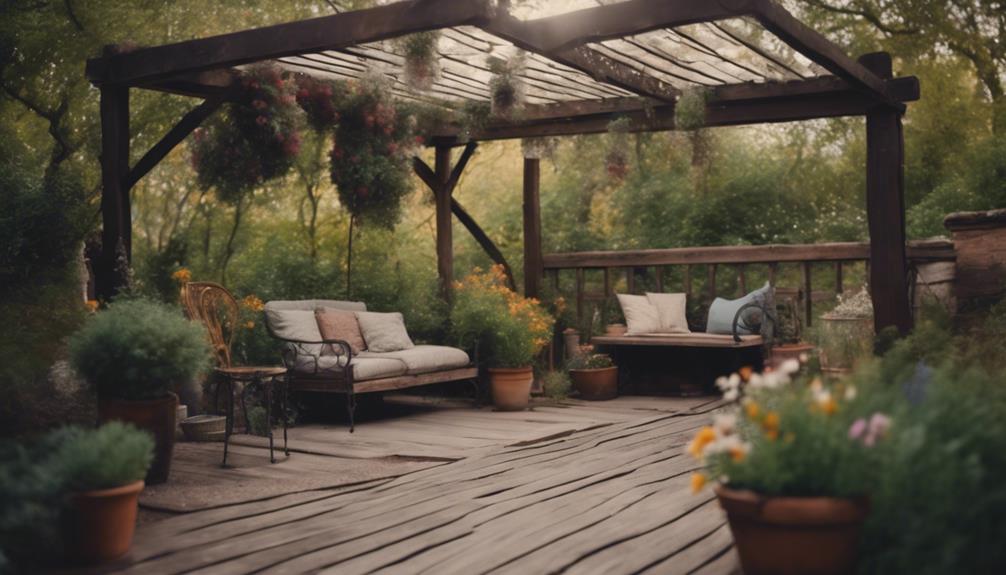
When it comes to flooring, you've got some fantastic options to enhance your outdoor space.
Reclaimed wood decking planks, flagstone pavers with moss, and terracotta tiles with grout lines each offer unique character and charm.
Choosing the right materials can set the tone for your entire design, so let's explore these choices further.
Reclaimed Wood Decking Planks
Reclaimed wood decking planks offer an eco-friendly and stylish flooring solution, transforming your outdoor space with their unique textures and rich history. By repurposing wood from deconstructed barns, factories, and other structures, you not only reduce waste but also introduce a rustic aesthetic that's hard to replicate. Each plank carries its own story, adding character and charm to your outdoor area.
Choosing reclaimed wood can also be more cost-effective than new hardwood, especially when you consider the durability and longevity of well-maintained planks. With proper treatment and sealing, these planks can withstand the elements, ensuring they remain safe and visually appealing for years to come.
In a country-inspired design, reclaimed wood decking creates a warm and inviting atmosphere that harmonizes beautifully with natural surroundings. Imagine hosting family gatherings or enjoying quiet moments on a deck that feels both timeless and unique.
Flagstone Pavers With Moss
Flagstone pavers paired with moss create a stunning, natural flooring option that enhances the rustic charm of your outdoor space. These pavers are a popular choice for country-inspired designs, available in various shapes and sizes to fit your unique style.
When you incorporate moss between the pavers, you not only boost the aesthetic appeal but also promote eco-friendliness. Moss retains moisture, reducing the need for extra watering, which is especially beneficial in varying weather conditions.
For installation, start with a solid base of crushed stone or gravel to guarantee proper drainage and stability. This foundation is vital for maintaining the longevity of your flagstone patio.
Since moss thrives in shaded or partially shaded areas, it's perfect for those nooks that get limited sunlight, providing a lush contrast against the stones.
Regular maintenance is simple; just trim the moss occasionally to prevent overgrowth and keep the joints between the flagstones clean. This upkeep will help maintain the visual appeal of your outdoor space, allowing you to enjoy a beautiful, rustic flooring option for years to come.
Terracotta Tile With Grout Lines
Terracotta tiles, with their warm hues and rustic appeal, create an inviting outdoor flooring option that can transform any space into a charming retreat. Their earthy tones are perfect for a country-inspired aesthetic, even in smaller yards. When you use terracotta tiles, the grout lines add definition and structure, allowing you to experiment with various layouts and designs to suit your style.
To guarantee your tiles last, proper sealing is essential to prevent stains and moisture absorption. This maintenance keeps their vibrant color intact over time. When installing the tiles outdoors, remember to create a slight slope for drainage. This prevents water accumulation, which could lead to damage or mold growth.
Installing terracotta tiles is a rewarding DIY project. You'll typically need a bed of mortar and careful alignment of the grout lines to achieve a professional finish. Taking your time during installation pays off, as it enhances the overall look of your outdoor space.
With terracotta tiles, you'll not only create a cozy retreat but also a durable flooring solution that stands the test of time.
Conclusion
By incorporating these key elements, you can create a charming country-inspired outdoor space, even without a large yard.
Focus on essential fixtures and furniture that maximize comfort and functionality.
Don't forget to add warm lighting and decorative touches that reflect your personality.
Finally, choose flooring that ties everything together while enhancing the rustic vibe.
With a little creativity, you'll transform your small outdoor area into a cozy retreat that feels like a slice of the countryside.
